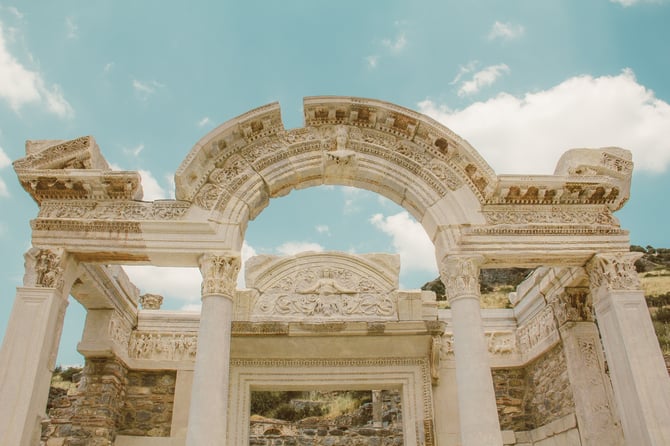In the modern age, designers of all kinds are heavily influenced by those that came before them. We see this in fashion, music, and even architecture; blends of ideas and styles from past time periods with the futuristic elements of the modern era. To better appreciate and understand the blended designs that surround us, it is important to first recognize our roots. In this series, we will explore all of the past styles of architecture and analyze how they impact the architecture of today.

Let’s go back to the very beginning; 5th century Greece and 3rd century Rome. Roman architect Marcus Vitruvius established the foundational principles of classical design. He stated that all buildings should have firmitas, utilitas, and venustas, which means that all buildings should have strength, utility, and beauty. Like many of the key points in Classical Architecture, this idea still holds true today. In fact, all structural openings (including posts of doors, windows, ceilings, and roofs) have evolved from the post-and-beam, or post-and-lintel system. Although it started in Ancient Greece and Rome, the term “Classical architecture” may refer to the architecture of later time periods that have been influenced by Greek or Roman forms of architecture. Architecture today that looks back to a classical past is considered to be Classical Revival architecture. Although not many residential buildings are still made in this style, they are a trend among government buildings; such as the U.S. Capitol building and the U.S. Supreme Court Building.
The different orders of Classical architecture:
Doric order: characterized by a simple and austere column and capital.
Ionic order: distinguishing feature is spiral scrolls of its capital, developed on the mainland of eastern Greece; used mostly for smaller temples and interiors.
Corinthian order: the defining characteristic is an ornate capital carved with stylized acanthus leaves.
The Romans used the Greek orders and also added two new ones:
Tuscan order: the simplest of the 5 orders of Classical Roman architecture, resembles the Doric order but has a simpler base and an unadorned frieze.
Composite order: developed in Rome, combines characteristics of both the Ionic and Corinthian orders.
The main characteristics of Classical architecture:
Classical design motifs
Homes feature dentil molding, medium pitched roofs, boxed eaves, decorative door surrounds, and broken pediments over the entryway.
Rectangular windows
Windows were commonly double-hung and included various types of symmetrical window configurations.
Building materials
Classical structures were built using the most sturdy and durable materials available, such as stone, brick, marble, and concrete.
Facades and pediments
A structure of this time period will typically feature columns and ornamentation in the front façade, and the upper area may have a triangular, arch-shaped structure called pediments that are often decorated.
Symmetry and proportions
The classical architecture followed the philosophy that all of the elements of a structure should have mathematically accurate proportions and congruous symmetry.

Some of the most notable examples of Classical architecture:
The Parthenon
A marble temple built during the height of the Ancient Greek Empire, between 447 and 432 B.C.. The Parthenon was designed by Pericles, who made the temple in dedication to Athena, the goddess of wisdom, arts, literature, and war.

The Erechtheion
Also designed by Pericles, the Erechtheion was the final piece to complete the collection of temples on the acropolis of Athens. Built between 421 and 406 BCE, this temple was made to house the ancient wooden cult statue of Athena, and to glorify the city in its Golden Age.

The Pantheon
Completed in 125 CE, the Pantheon is considered to be the most well-preserved building from Ancient Rome. Although the purpose of the structure is not known for sure, the remaining elements suggest it to be a temple of sorts or a place for the emperor to make public appearances.

Classical architecture made its return in 1750 AD to 1920 AD, in the form of NeoClassical (or Classical Revival) Architecture. Some of the world’s most well-known landmarks were built in this unique style, which successfully revived the ways of the ancient Romans and Greeks. The original Classical architecture has since been followed by many different styles over time; Romanesque, Gothic, Renaissance, Baroque, NeoClassical, Art-Deco, Modernism, PostModernism, and what we see today- Parametricism. Each style speaks to its time period while still holding true to the original values of the Ancient Greeks and Romans, and it is fascinating to compare each one to another.
Classical Architecture’s Impact Over Time
Elements of this style of architecture have continued to appear in trends throughout history. Particularly in the early stages of American architecture, when this style was used heavily on Government buildings. The elegance and drama of this style influenced many of the most popular architectural styles, such as Victorian. If you are looking to integrate parts of this style into a project of yours, Designblendz has a team of designers who are wildly creative and will be happy to help you come up with the results that you deserve.
Sources:
https://www.britannica.com/art/Classical-architecture
https://www.Masterclass.com/articles/classical-architecture-guide#quiz-0
https://www.Thespruce.com/classical-architecture-4797909
https://www.history.com/topics/ancient-greece/parthenon
https://www.worldhistory.org/Pantheon/
https://www.worldhistory.org/Erechtheion/




